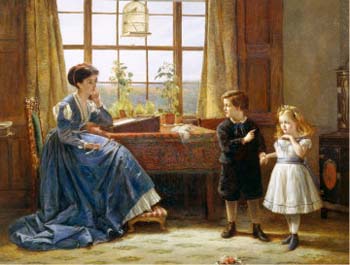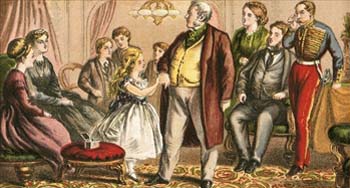 |
Formation of Children
The Basics of the Introduction
Marian T. Horvat
Jane Finley was playing checkers with her friend Karen Martin on the kitchen table when Mother came home from the grocery store. Jane looked up and said, “Hi, Mom. This is Karen. Remember I told you I was inviting her over to play.”

The Introduction by George Kilburne |
“Hi,” said Karen.
“Glad to meet you, Karen. Make yourself at home.”
The introduction over, the two girls returned to their game.
What is wrong with this picture? Almost everything.
First, Jane and Karen should know to stand when an adult enters the room.
Second, Jane should have introduced her mother first and presented her friend by her full name. “Mother, this is Karen Martin, the friend I told you about who is in my art class. You gave permission for me to invite her to visit and stay until dinner time.”
Third, Karen should have acknowledged the introduction with something more than a casual “Hi”, e.g. “I’m glad to meet you, Mrs. Finley ,” or “It’s a pleasure to meet you. Can we help you bring in the groceries?”
Mrs. Finley also could have responded in a less casual way. “I’m pleased to finally meet you, Karen. Jane has spoken often of you.” The casual “Make yourself at home” is an exaggeration in a first introduction. In fact, a bit of formality would be better since the first impression is the one that usually establishes who a person or family is. When Karen returns home, she will most likely describe the manners and customs of the Finleys that she observed on her first visit.
The reciprocal is also true, Mrs Finley is checking - by the manners and appearance of Karen - who the Martins are. So, in better times than today, the first introduction of a person - even a teenager or a child - took place with the concern of giving and receiving a good impression.
A proper introduction used to be a normal procedure in a good home. Today it is increasingly rare, often not because of a deliberate rudeness on the part of children, but simply because they never learned. And many times they were not taught because their parents never knew the rules to teach them. It is time to rectify this situation.
Regaining the lost art of introductions
Introductions are important for various reasons. They make the unknown party feel welcome and comfortable. They acknowledge differences in gender, age, and status, deferring to ladies, the elder, and the more distinguished. In Catholic societies that respected hierarchy and propriety, making introductions became a veritable art form.
Here, I am interested in reviving the simple introductions encountered in day-to-day living, not the more complicated ones involving Bishops and senators. If you are unfamiliar with how to make a proper introduction, a good place to begin is to rehearse making them inside the home with your family. A bit of practice will make the public introduction natural and fluster-free.
Remember, begin the introduction calmly. Do not rush. Stop a moment to compose yourself and think about the precedence and what you will say. By precedence, I mean the proper order of presenting the persons to show the appropriate honor and respect.
If you know these three basic formulae, they will apply to almost every situation:
- Lady, meet gentleman.
- Older person, meet younger person.
- More distinguished person, meet less distinguished person.
Here are some simple applications of the rules:
- “Mrs. Jones, I would like you to introduce you to Mr. Adams.”
- “Mrs Kostelac, this is my friend John Becker.”
- “Fr. Markey, may I present my mother Barbara Kruse.”
If you are introducing someone to a small group of people, you can simply say: “I would like to introduce my family to Matt Gerald. Matt, this is my Father and Mother, my sisters Kate and Ellen, and my brother Philip.
To facilitate conversion, it can be helpful to add a brief description of the party you are introducing: Annette, this is my cousin, Christine Phillips, who lives in Wisconsin. Like you, she is an opera fan.” But keep it brief. An introduction should not be a life résumé or a manifestation of affection or admiration.
“Maria, I want you to meet my very best friend in the whole world, Jeanette. She is the sweetest girl you will ever meet.” This sounds very artificial and out of place. It is gauche to imply that the others should also admire a person just because you do.
Standing for adults and ladies
Surely it is time to revive the custom of children standing when an adult enters the room. When I was in grade school at St. Patrick’s School, this was a steadfast rule. When Sister or Father – or any visiting adult – entered the room, we would all rise, stand straight on both legs, our hands at our side, and chorus, “Good morning, Sister Margaret Mary,” or “Good afternoon, Father Kelly.”
We remained standing and silent until we were told we could be seated again and resume our work.

At a family gathering the guest meets the host's daughter |
Now, we are not saying that every time Mother enters the room all the children must stop what they are doing to stand. Members of a household do not rise, since seven or eight persons getting up and down several times an hour would produce an effect less of politeness and more of confusion.
However, when Mother enters the room with the neighbor lady, the children should rise and greet the guest. Should Mother and Father return from a dinner engagement and enter the living room, the children should stand to greet them. When the family is entertaining company, the children should rise for every older guest who enters the room and remain standing until he or she is seated.
If an introduction is made, a child should respond, “How do you do,” or “I am glad to meet you.” But never “Hi” or “Hey.”
A good way to help remember names is to repeat the name of the person you are meeting in your response, “It is nice to meet you, Mr. Rogers.” This is a fine habit to teach your children, especially the shy or self-conscious ones, so that they learn to pay attention during the introduction..
In days past, if young persons were meeting a distinguished person, the young man would bow slightly, and the young lady would give a small curtsy. Certainly I am not opposed to such behavior.
Giving the good example
It is well and good for adults to establish such rules of courtesy for their children, but they should not expect compliance unless they provide the good example.

It is customary for gentlemen to open the door for ladies |
Men should always stand when introduced to women of all ages. Gentlemen also stand when a lady – but not a child – enters the room, and remain standing until she is seated. At any rate, every gentleman stands as long as his hostess or any other lady does, unless she bids him to be seated.
We are in lamentable times when a grown man wearing a baseball cap can be slouching on a sofa watching TV when his wife’s mother enters the room and he barely, if at all, acknowledges her presence. Remember, a gentleman always rises when a lady guest enters the room. He also removes his hat when he meets a lady outdoors.
If parents follow the courteous patterns of the past, their children will follow their lead. The best way to teach manners is to practice them.

Posted September 18, 2009

Related Topics of Interest
 Let’s Not Forget the Greeting Let’s Not Forget the Greeting
 The Value of Distinction The Value of Distinction
 Dressing Well - Vanity or Virtue? Dressing Well - Vanity or Virtue?
 St. Isidore of Seville on the Importance of Being Dignified in Manner St. Isidore of Seville on the Importance of Being Dignified in Manner
 Introduction to the Small Manual of Civility Introduction to the Small Manual of Civility
 The Importance of One's Bearing The Importance of One's Bearing
 Four Ways to Discern a Man's Soul by His Appearance Four Ways to Discern a Man's Soul by His Appearance

Related Works of Interest
|
|
Formation | Cultural |
Home | Books | CDs
| Search | Contact Us
| Donate

© 2002- Tradition in Action, Inc. All Rights Reserved
|
 |
|